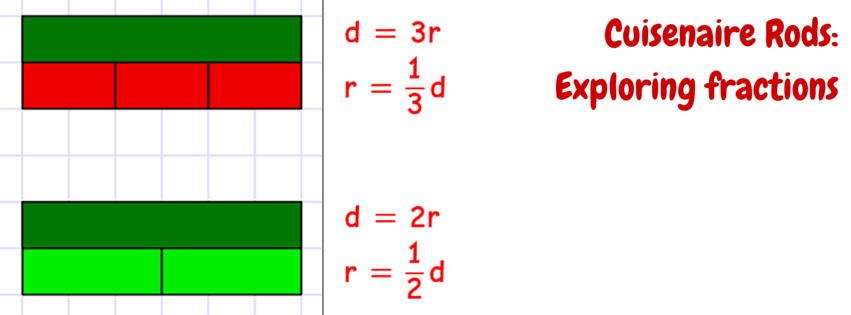As per instruction, I am attempting to finish strong, and I had another really interesting lesson with Year 7 using the NRich Cuisenaire environment today, so I thought I’d go out in style with that.
Last Tuesday we did plenty of work with whole numbers and algebraic notation, and I was really keen to explore some fractions with them today; we completed a big unit of work on fractions before half term, but some of them didn’t do so well when I assessed them, so I need to keep coming back to this with them.
A key issue that we’ve been trying to work around is the meaning of the numbers in a fraction; we’ve reinforced this loads with bar modelling, but the Cuisenaire stuff links in so nicely that I decided we’d take the opportunity to attempt some fractional expressions.We started with a quick refresher, then we had a go at the first activity here, comparing one rod to another. We looked at links both ways, so wrote 6w = d first, then w = 1/6 d. It took a lot of annotating and re-explaining for them to completely get the idea, and I think I need some more problems along these lines to make sure they are really confident. The links to later work on solving equations and inverse operations are really clear though!
Next, we had a look at situations where the two Cuisenaire expressions weren’t the same length. I wanted them to focus on just comparing part to whole here, so we only really talked about y = 5/6d, but at some point we’ll go back and explore d = 6/5y further. This links so well to mixed numbers and improper fractions, as well as later work using proportional reasoning and scale factors.
We then had a go at the second task (scroll down on previous link), getting them to write statements to compare different sizes. I need to develop this further, because the level of difficulty ramped up too much for some of them. The couple who got it straight away were happy to continue to find their own expressions, and developed some quite complex ideas!
I’m definitely adding Cuisenaire rods and the NRich environment to my repertoire – the pupils are finding them really engaging and they’re a good stepping stone on the way through algebra tiles to abstract representation. Just got to keep tweaking these lessons and make some more resources now!
